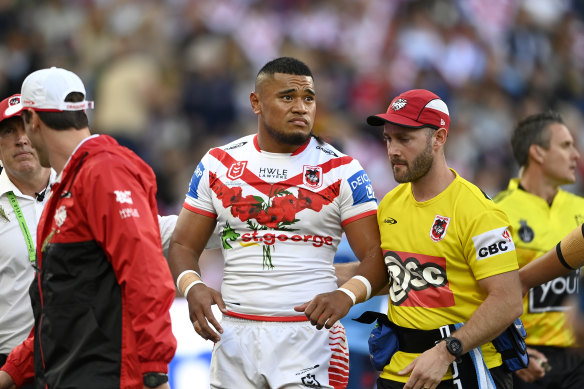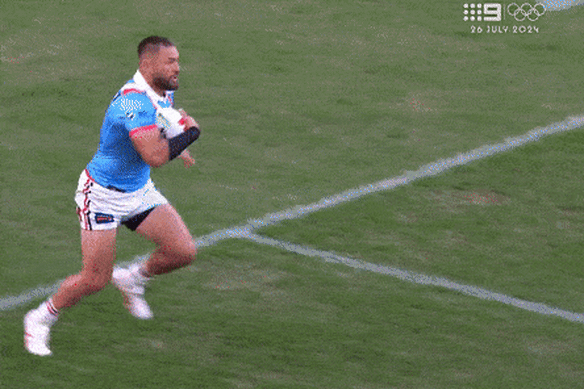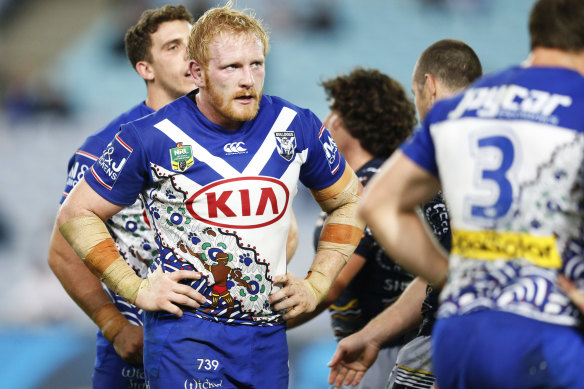This was published 11 months ago
Opinion
The expert opinion is in: NRL must take on the kick-off concussion issue
Peter FitzSimons
Columnist and authorIf it please her honour, in the class action of Brain-Damaged NRL Players vs The NRL 2035 – alleging that the league administrators grossly breached their duty of care to their employees by allowing long kick-offs to continue, long after it was known what damage they caused – I cite a column published by the Sydney Morning Herald on May 2, 2024. Call it Exhibit A, and I table it to demonstrate that the risks were known at the time, but ignored. The column went like this ...
You wouldn’t credit it, would you?
Last week, as discussed, we had the most revered rugby league player of the modern era, Wally Lewis, making a landmark speech that he was living with early dementia from having had too many concussions, even as his speech was bookended by two other veterans with concussion issues announcing their retirements.
This week?
Well, this week we still have people saying that a source of concussions in the NRL, the long kick-off, is no problem, and that all of us who advocate changing it for the sake of sanity, are somewhere between engaging in a silly debate and out to destroy the game. No, seriously.
One article defending the idea of keeping long kick-offs has it that it ain’t that big a deal because only 3.4 per cent of all concussions can be attributed to kick-offs.

Moses Suli was concussed in the first tackle of the Anzac Day clash.Credit: NRL Photos
And this is acceptable to the NRL? It is not acceptable to the experts.
One of the world’s foremost concussion advocates is Dr Chris Nowinski, and he was clear when I asked him about it, immediately drawing parallels with the NFL.
“To prevent CTE [chronic traumatic encephalopathy], we have to reduce both the number and strength of head impacts,” the Bostonian said. “Studies show kick-offs in American football cause many of the highest magnitude head impacts. Changing the kick-off was thought to be untouchable, but the NFL just made the unexpected move of dramatically changing them for the 2024 season to protect players.”
Under enormous legal pressure to make the game safer – or face billions of dollars in payouts – the new NFL rules start next season and while the ball will still be kicked from the kicking team’s 35-yard line, all players on the kicking team must start with at least one foot on the returning team’s 40-yard line. Get it? By restricting the space between the one receiving the ball and those who would tackle him, you lessen their speed and limit the impact, and so limit the damage. Simple as that.
And the National Rugby League, Chris?
“Any league serious about preventing CTE has to consider getting rid of, or changing plays, like the kick-off, where extraordinary head impacts are inevitable. There is no question kick-offs as they are played today in NRL meaningfully contribute to players developing CTE. How many former players have to be diagnosed with CTE before we put all options on the table to prevent CTE? Changing kick-offs is low-hanging fruit.”
Got it?
When this comes up in a future class action, let the record show: one of the world’s foremost sports concussion experts has no trouble identifying the NRL’s long kick-offs as a source of brain damage in the game, and calls for change, just as the NFL has done, and for precisely the same reasons.
Finally, Nowinski also notes that while judging the specific legal liability of a particular play is difficult, the fact that at the moment the NRL is not even countenancing it, “shows convincingly that they aren’t even trying”.
Still the defenders of the practice carry on with their reasoning that it is not obvious that things must change.
According to them, the problem doesn’t come from having one 110kg-120kg man charging full tilt at three men of much the same dimensions. No, no, no. It is a problem with tackling technique, don’t you see?
“Timing and technique are everything,” St George Illawarra coach Shane Flanagan said of the concussion suffered by his centre, Moses Suli, in the first tackle of the Anzac Day match when his melon hit the elbow then head of Roosters prop Jared Waerea-Hargreaves.
“We’re going to talk about it today then practice getting it right. We’ll react to what happened with Moses and work on our technique on kick-offs.”

Moses Suli takes a brutal hit early in the Anzac Day clash.Credit: Nine
Great, coach. Let’s say, for argument’s sake, all your players can execute boot-lace tackles from now on, and your blokes are safe. Do you think all teams, including juniors, can be coached to safety? Does anyone at the NRL with the first clue of medical and legal ramifications of continuing the practice, believe this?
Hands up, those who truly think that three blokes running full tilt at another bloke running at full tilt can somehow, some way, be made safe?
“But rugby league won’t still be rugby league!” they say.
Seriously? Do we have to go through that, again?
The dinosaurs always said that kind of thing, with every step forward to make the game safer, from banning shoulder-charges to introducing HIAs, to having compulsory stand-downs for those concussed, and all the rest.
When rugby union determined that having the front-rowers of scrums slamming into each other was causing a shocking number of scrum collapses and those same front-rowers were ending up in wheelchairs, it rightly changed the rules so they would have to “touch, pause, engage”. The frequency of shocking accidents diminished accordingly. Rugby union was still rugby union.
The NFL will still be NFL after its latest rule change to diminish the damage done by kick-offs. When the NRL changes this – as it must – it will still be rugby league. This is despite the likes of James Graham – who once said, “if you don’t like how tough it is, go and play Oztag,” arguing on NRL 360, “If you want the game to be [completely] safe, you’re playing the wrong game. You’re watching the wrong game. You cannot.”
Thanks, James. We get that football can never be completely safe. But how obvious is it that it has to be made safe-er?
You are on the record as noting that your own brain is “losing volume”. You said on your podcast: “While the neuropsychological tests I passed quite well … it has been confirmed via an MRI scan that part of my 36-year-old brain is damaged, that is ‘down on volume’ at the front and side part of my brain.”

James Graham made 135 appearances for the Bulldogs.Credit: NRL Photos
James, it was very courageous of you to share your medical situation, and I for one say bravo. But what is the point of going public if we don’t learn and try to protect the next guy? James, you and I – and I hope I’m OK, but don’t know – cannot go back in time to undo whatever we have done to our brains. But we can do our best to save those playing today, even if they don’t get that they need to be saved. If we don’t make changes, 40 years from now we’ll have to listen to the next Immortal saying, “If only we had known”.
We know, now, and need to say so.
So, just where do you draw the line at making the game safer? I will go with drawing the line at brain health, at not insisting on keeping a minor part of the game that is causing damage being done.
The game has a legal and moral obligation to sort this stuff.
As to how you’d change the rules, there are lots of tweaks possible. An obvious one would be to say if the receiving team catches it in their own 20, they get seven tackles. If that doesn’t change long kick-offs, make it their own 30 metres. Tweak it. Work it. Make it safer.
Thank you, your honour.
Sports news, results and expert commentary. Sign up for our Sport newsletter.
NRL is Live and Free on Channel 9 & 9Now